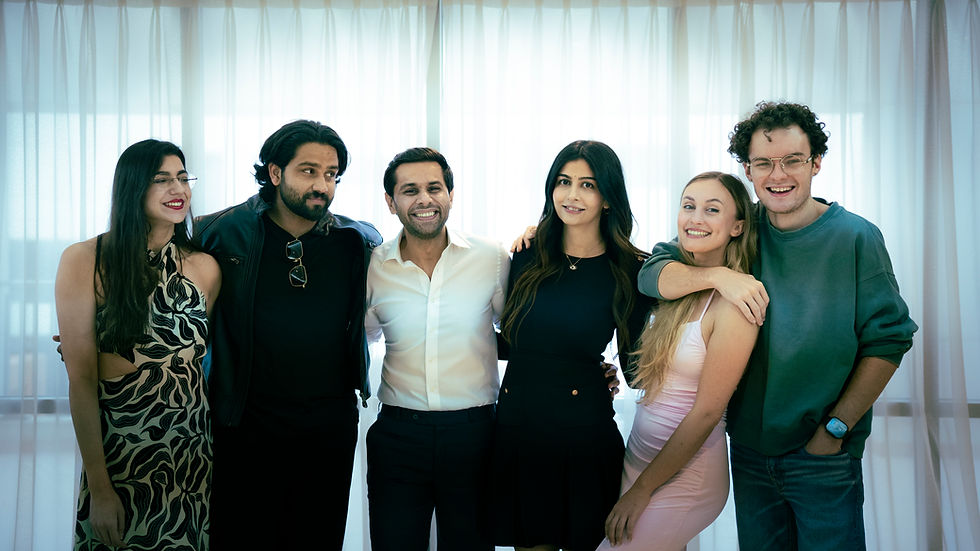A jewel is never just a jewel
- From the desk of Stories Over Art

- Aug 20
- 3 min read
For someone like me — a curious observer of art, culture, and now, jewelry — this wasn’t just a lecture. It was a time-traveling experience that spanned continents and civilizations, revealing how jewelry is far more than mere ornamentation. It’s protection, prayer, power, and a whisper of the past clinging to the present.
Authored by Shrutika Gosavi
Stepping into L’ÉCOLE School of Jewellery Arts Dubai is like entering a world where time stands still, and stories are told not through words but through metals,gems, and age-old symbols. With its curated lighting, statement chandeliers, and sunlit classrooms, the space doesn’t just shine — it sparkles with intellect and history. It was here, in June 2025, that I found myself immersed in the course “The Power of Jewellery: Amulets, Talismans, and Lucky Charms,” led by art historian and curator Dr. David Usieto Cabrera and heritage specialist Ms. May El Hage.
For someone like me — a curious observer of art, culture, and now, jewelry — this wasn’t just a lecture. It was a time-traveling experience that spanned continents and civilizations, revealing how jewelry is far more than mere ornamentation. It’s protection, prayer, power, and a whisper of the past clinging to the present.

Shrutika Gosavi is an acclaimed artist, poet, and art educator based in the UAE. Holding a Master’s in Fine Arts, she has received several international awards and fellowships. A full-time visual artist living in Sharjah for over a decade, she has created an extensive body of work that explores human emotions and the soul’s relationship with the world. She is also building the Urban Sketchers Sharjah Chapter, fostering a creative community.
Jewellery Beyond Beauty
As Dr. Cabrera and Ms. El Hage guided us through the session, one truth emerged clearly: a jewel is never just a jewel. It carries with it the energy of stones, a profound connection to belief systems, the secrets of ancient craftsmanship, and sometimes even the spirit of the cosmos.
Our journey began in the Paleolithic era and moved through Megalithic cultures, ancient Egypt, Catholic Europe, Islamic
traditions, and across China, India, and North America. In each culture, we found jewelry infused with sacred intent — sometimes protective, sometimes aspirational.
We learned to differentiate:
Amulets: Protective pieces believed to guard against negative energy. Think the evil eye, khamsa, and scarab rings — symbols worn daily yet rooted in sacredness.
Talismans: Intentionally crafted to attract love, strength, and luck. Personalized pieces like engraved rings or energy- charged crystals.
Lucky Charms: Often superstition-based, meant to invite fortune — the four-leaf clover, horseshoe, and ladybug being global favorites.
These aren’t just categories — they are windows into human longing, faith, and the need to feel safe and seen.
History Meets Pop Culture
One fascinating detour led us to the story of Elizabeth Taylor’s charm bracelets, inspired by Balangandãs — symbolic, multi-charm pieces carried by enslaved Africans to Brazil. Over time, these evolved from spiritual protectors into artistic expressions of cultural memory and resilience. This intersection of history and Hollywood highlights how these ancient ideas persist and grow. From jade in China, symbolizing virtue, to Dzi beads in Tibetan Buddhism, believed to hold cosmic energy, we began to see how stones themselves are revered across cultures — not just for beauty, but for their spiritual essence.
Ancient Beliefs, Contemporary Luxury
Even modern luxury brands echo these ancient beliefs:
Van Cleef & Arpels’ signature four-leaf clover reflects hope and luck.
Cartier’s panther embodies strength and sensuality.
Chanel’s pearls and leopards, Bulgari’s snake, David Webb’s animal totems, Hemmerle’s amulets, and Dior’s Signs of Identity charm bracelet — all draw from spiritual or protective roots, remixed into contemporary elegance.
These aren’t random motifs — they’re powerful echoes of belief systems that have endured for centuries.
Touching the Past, Literally
What made the course truly engaging were its hands-on elements. We identified our birthstones using charts based on zodiac and birth eras — a surprisingly intimate exercise. Holding uncut stones and feeling their texture and temperature added another layer of connection. These weren’t just objects anymore; they were companions with memory and meaning.
The final activity brought it all together: categorizing jewelry pieces on a map by region and style — abstract, nature-inspired, calligraphic, or universal. It was like curating a mini-exhibition, guided by everything we had absorbed.
A Personal Takeaway
As I received my certificate of completion, I realized what I was taking away was far greater: a new lens. Jewellery isn’t simply about adornment— it’s about belief systems, protection, identity, and memory. In every charm or talisman, we carry a bit of hope, a plea for love, a shield against harm.
Whether worn for faith, superstition, or fashion, jewelry has — and always will — carry stories. In a world that constantly changes, that enduring power remains beautifully timeless.
















Comments